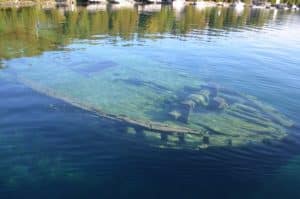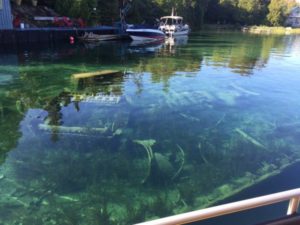Bruce Anchor Cruises will take you on a glass bottom boat cruise to see these two shipwrecks.
Book your cruise today!
THE SWEEPSTAKES
The Sweepstakes was built in Burlington, Ontario, in 1867 by Melancthon Simpson. The two-masted wooden schooner’s length was 36.3 m (119 ft) and the hull’s maximum depth was 7 m (20 ft). The schooner weighed approximately 218 tonnes. The Sweepstakes was last owned by George Stewart, who lived in Mooretown, Ontario.
Sinking
Damaged off Cove Island in August 1885, the Sweepstakes was towed to Big Tub Harbour’s head, located in the Fathom Five National Marine Park, by a tugboat known as Jessie. The schooner suffered serious damage and was not repaired in time, causing it to sink in September 1885. The Sweepstakes was transporting coal, which was retrieved after the boat sank.
The wreck today
Today, Sweepstakes is said to be near picture perfect, as the hull remains mostly intact. The Sweepstakes is located approximately 50 yards from the head of Big Tub Harbour and remains in the water at a depth of 20 feet. The bow area of the boat contains the windlass and portions of the starboard railings. The stern name-board has been removed and is currently on display at the Bruce County Museum in Southampton. The center-board box is in the middle of the schooner, with the centreboard inside. This extends from keel to deck. The aft deck of the Sweepstakes has collapsed, causing the stern-post to fall, where it now lies on the bottom of Big Tub Harbour. The Fathom Five National Marine Park has made repairs to the slowly deteriorating schooner to keep the deck from collapsing. Although Sweepstakes deteriorates a little more each year, it is said to be one of the best-preserved 19th-century Great Lakes schooners and is considered one of the most popular shipwrecks in the Fathom Five National Marine Park. The schooner gives a good depiction of what a typical Great Lakes schooner looked like. Entry into the schooner is no longer permitted to divers. The Fathom Five National Marine Park officials have put up fencing to prevent entry into the schooner. This reduces any further damage to the schooner, which could be caused by the exhaled bubbles of the divers.

